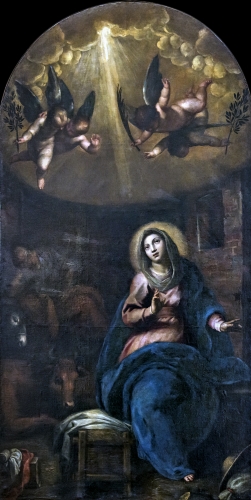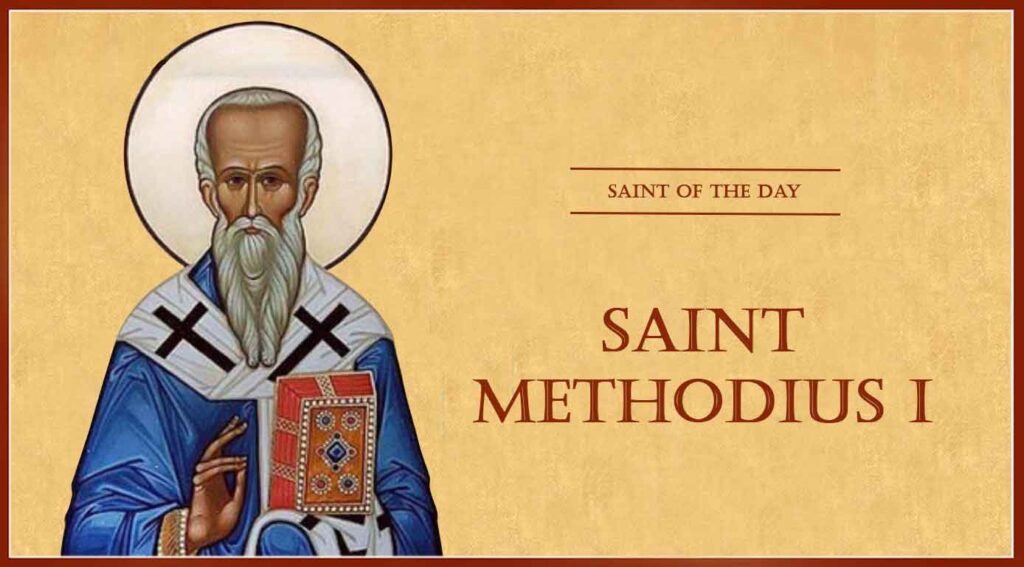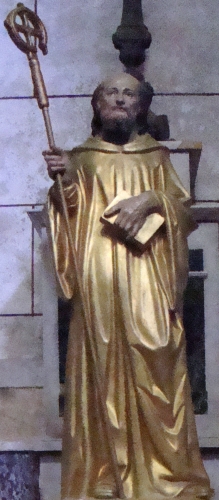1256–1302; Patron Saint of nuns; Invoked for poor souls in Purgatory; Equivalent canonization in 1606; Added to the Universal Roman Calendar by Pope Clement XII in 1677
Saint Gertrude the Great is the only female saint to be given the title “the Great,” which Pope Benedict XIV bestowed on her in the mid-eighteenth century as a way of highlighting her extraordinary contribution to mystical theology. Nothing is known about Gertrude’s early childhood or family origin, other than that she was born in Eisleben, Thuringia, in the Holy Roman Empire, modern-day Germany. At the age of five, she was entrusted to the Monastery of Saint Mary in the neighboring town of Helfta, which was later moved to Hackeborn property. Why she entered the convent at such a young age is not known. Most likely, either her parents offered their daughter to God in this then-customary way, or Gertrude might have been an orphan.
When little Gertrude entered the convent, the abbess was of the same name, Gertrude of Hackeborn (now Blessed Gertrude of Hackeborn). Abbess Gertrude was an outstanding woman who governed the monastery for forty-one years, helping it to flourish and produce much good fruit. It is often called “the crown of German convents.” She was exceptionally devout and saw to it that the sisters regularly contemplated the boundless love of Christ, were serious about their souls’ journey toward divine union, had a profound love for the Sacred Heart of Jesus, and manifested a deep devotion to the Most Holy Eucharist. Daily life at the monastery consisted of singing, praying the Divine Office, celebrating the Mass, and studying Scripture and the Church Fathers. In addition, the sisters engaged in ascetical practices, manual labor, community life, and menial daily duties. When little Gertrude entered the convent, Abbess Gertrude was around twenty-nine years old. Also in the convent was the abbess’s younger sister, Matilda of Hackeborn (now Saint Matilda), who was about twenty, and to whose care the five-year-old Gertrude was entrusted. Sister Matilda went on to become her dearest friend and spiritual mentor.
Sister Matilda had been at the convent since she was very young, and she quickly grew in sanctity and virtue, eventually probing the highest heights of holiness. This had a profound impact upon the community and drew the other sisters into deeper prayer. After young Gertrude had been at the convent for about ten or fifteen years, Sister Matilda began to have visions of Christ, the Blessed Virgin Mary, angels, and saints in which she became intimately aware of the finest and most splendid details of their lives, especially the life and Passion of Christ and the life of the Blessed Mother. She also was infused with profound knowledge and insights into the mysteries of our faith, such as the Sacraments, virtues, and the end of time. Finally, she was the recipient of many beautiful prayers. Unbeknownst to her, her sisters, under the direction of Abbess Gertrude, began to write down everything Sister Matilda experienced and received.
Around the same time, another Matilda—of Magdeburg—moved into the convent in Hackeborn at the age of sixty-five. Matilda of Magdeburg had lived a solitary life of prayer and charity and was also a mystic. At the age of twelve she had her first vision, a vision of the Holy Spirit, and later began writing these visions down. By the time she moved into the convent in Hackeborn, she had written six volumes. At Hackeborn she completed her seventh book, The Flowing Light of Divinity.
This bigger picture of life at the Monastery of Saint Mary paints the background for Saint Gertrude the Great, whom we honor today. Sister Gertrude was blessed with a holy and disciplined mother abbess. Her mentor and dear friend, Sister Matilda of Hackeborn, was a mystic. When the aged Matilda of Magdeburg moved into the convent (most likely not taking formal vows), she was in the presence of another mystic. What could she do but become a mystic herself? The problem was that up until that point, Sister Gertrude had not yet fully given herself to Christ. She was an excellent student with a strong desire to study all the sciences and other subjects of that time. She excelled in literature, music, and art. She prayed and was also strong-willed and determined in all she did. However, as she aged, she began to see the futility of the things of this world and grieved over her lukewarmness.
In January 1281, when Sister Gertrude was twenty-five years old, she had her first mystical vision. Jesus, in the form of a most beautiful young man about sixteen years old, appeared to her saying, “Your salvation is at hand; why are you consumed with grief?…I will save you, I will deliver you; fear not.” After that, the youthful Jesus placed His hand on her to ratify His promise. Jesus then said to her, “You have licked the dust with My enemies, and you have sucked honey amidst thorns; but return now to Me—I will receive you, and inebriate you with the torrent of My celestial delights.” She then saw a thorny hedge that divided her and Jesus, representing her many sins, and she saw Jesus stretch out His hand, which bore the marks of the nails but communicated to her His promise to draw her to Himself. Of this encounter she later wrote:
By these and other illuminations, You did enlighten and soften my mind, detaching me powerfully, by an interior unction, from an inordinate love of literature and from all my vanities. I only despised those things which had formerly pleased me; and all that was not You, O God of my heart, appeared vile to me. You alone were pleasing to my soul. And I praise, bless, adore, and thank from my inmost soul, as far as I am able, but not as far as I ought, Your wise mercy and Your merciful wisdom. You, my Creator and Redeemer, did endeavor in so loving a manner to submit my unconquerable self-opinionatedness to the sweetness of Your yoke, composing a beverage suitable to my temperament.
For the next twenty-one years, Sister Gertrude lived a life of ongoing mystical prayer, especially during the Divine Office and the Holy Mass. She began to have regular visions and received spiritual knowledge, writing much of it down. She turned from interest in the vain things of this world to the exclusive contemplation of God and experience of mystical prayer, aided by her study of Scripture and the Fathers of the Church.
The legacy of Saint Gertrude the Great is one of the most important ones from the thirteenth-century mystics. During her final twenty-one years of life, she entered into deep union with God and shared those experiences in numerous writings, some of which have been lost. Her most important surviving work is The Herald of Divine Love, consisting of five chapters, the second of which she herself wrote and the rest which were written by other nuns, recording her life, spiritual experiences, and insights as she related them. Her book, Spiritual Exercises, a compilation of prayers, meditations, and spiritual practices, helps the reader grow in devotion, virtue, a love for the Eucharist, and devotion to the Sacred Heart, to which she was especially faithful. Saint Gertrude also learned from Jesus about the importance of praying for the poor souls in Purgatory. He gave her a prayer that we will use to conclude this reflection in honor of Jesus’ command to her.
Saint Gertrude was never formally canonized, and her writings were nearly lost until they were discovered centuries after her death. In the seventeenth century, she was honored by the Church and received an “equivalent” canonization. In the eighteenth century she was placed on the Universal Roman Calendar, and her prayers and revelations began to be more widely known. It might be that God especially wanted to use her to reveal His inner life to the Church today, many centuries after her death. Consider learning more about this mystic and her writings so that God can infuse you with some of the same insights and grace He gave to her.
Source: https://mycatholic.life/saints/saints-of-the-liturgical-year/november-16—saint-gertrude-the-great-virgin/








